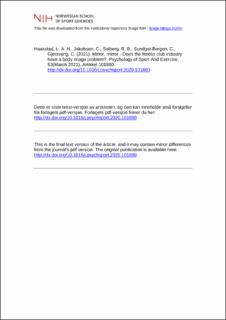| dc.description.abstract | The primary aim of the present study was to report longitudinal data on body image across the first year of gym engagement. Second, we aimed to compare body image among those who reported regular use of the fitness club (≥2 sessions/week) with those who did not (≤1exercise session/week or no exercise/dropout), as well as between genders and Body Mass Index groups (BMI<25 and BMI≥25) at membership start-up. Novice exercisers (n = 250) from 25 fitness clubs in Oslo (Norway) responded to an online questionnaire at start-up, three, six and 12-months follow-up, with a high response rate (100%, 89.6%, 85.2% and 74.8%). The questionnaire covered background/health information and exercise involvement. A modified Multidimensional Body Self Relations Questionnaire Appearance Scales (MBSRQ-AS), comprising five subscales (appearance satisfaction, appearance investment, weight-related attitude, self-classified weight and Body Areas Satisfaction Scale (BASS), was used to gather repeated measures of body image. Data were analysed separately for each subscale and as a body image total score, using a linear mixed model adjusted for baseline, gender and BMI. We found differences in body image total score reported at six months when compared with onset (0.04, 95% CI 0.005–0.078, p = 0.024), whereas the subscale appearance satisfaction was different at three (0.08, 95% CI 0.015–0.164, p = 0.018), six (0.11, 95% CI 0.039–0.197, p = 0.003) and twelve (0.10, 95% CI 0.021–0.179, p = 0.013) months when compared with onset. Also the subscale BASS was different at three (0.17, 95% CI 0.009–0.255, p < 0.001), six (0.21, 95% CI 0.127–0.301, p < 0.001) and twelve (0.26, 95% CI 0.143–0.388, p < 0.001). Participants adhering to regular exercise (≥2 times weekly) had better outcomes on total body image than those who exercised less frequently or irregularly (three: 2.94 vs. 2.83, p = 0.027 and 12-months: 2.97 vs. 2.85, p = 0.028). At membership start-up, being male (p < 0.001) and having a BMI<25 (p = 0.003), were the strongest factors associated with reporting a higher score on total body image. In conclusion, we found improved body area and appearance satisfaction in novice exercisers across the first year of fitness club membership. | en_US |
